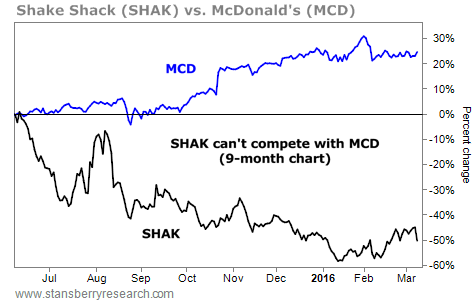| Home | About Us | Resources | Archive | Free Reports | Market Window |
Here's How You Beat a Down MarketBy
Wednesday, March 9, 2016
I started writing Retirement Trader in 2010 to show folks like you how to take advantage of my experience in the options market... I wanted to share the techniques I learned on Wall Street in an easy, understandable format.
And as many of you already know, our strategy posted an incredible record in the bull market from 2010 through today... so much so that others have tried to copy us and make similar claims to success.
But this year, the market had a terrible start. It was the worst January since 2009. Our inbox was flooded with investors who were scared.
As I've shown you, this type of market action and correction is normal. (And in fact, the market has worked its way higher since then.)
But the fear that it sparked brings up a good question: Which strategy should you be using if the market provides flat or negative returns in 2016?
Today, I'm going to take the time to answer how and why we can profit in a down market...
Right now is the ideal time to be selling options on high-quality businesses.
Option selling is less risky than holding stocks outright.
When you sell an option, you generate income that lowers the total cost of your position (your so-called "cost basis"). That gives you a downside cushion.
In addition, down markets can make things better for option trades. When volatility surges, we earn more income when we sell (to open) an option position.
But rather than explain how these things help, we can show how a similar strategy that we use at Retirement Trader has historically beaten the market, even in down markets.
The Chicago Board Options Exchange (known to traders as the CBOE) maintains an index called the S&P 500 PutWrite Index. This index measures the returns of a strategy that consistently sells put options, expiring in one month, on the S&P 500 Index.
And as you can see in the following chart, it consistently beats the market...
 Option selling generates better long-term returns as markets rise.
And during explosive down markets – even during market crashes, like we saw in 2000-2003 and 2008-2010 – this option-selling strategy works better than holding stocks themselves.
Almost any option seller should be able to outpace the market with a simple, rules-based strategy... without having to pick stocks or time the market.
Our Retirement Trader put-selling strategy is similar to what the PutWrite Index does. But instead of selling puts on the broad-market index, we use individual stocks and funds to help us focus on specific opportunities or sectors.
And we tend to sell options with a two-month time frame. That's the "sweet spot" where we can earn the most income in the shortest amount of time. It's one of our many secrets to option selling.
Finally, it bears repeating that the biggest rule we have for ourselves and for Retirement Trader subscribers is: Only sell options on stocks that you actually want to own.
That helps make our option-selling strategy less risky than owning the stocks themselves.
We can't predict the market's next move. But by selling options on high-quality stocks, we don't have to.
Here's to our health, wealth, and a great retirement,
Dr. David Eifrig
Further Reading:
Earlier this year, we shared a special three-part options-selling series from Doc. You can learn more about his strategy below:
Market Notes'BORING' WORKS: BURGER EDITION Today's chart is another reminder that when it comes to successful long-term investing, it's best to stick to the proven, time-tested companies... and resist the temptation to invest in the newest fad business...
We've covered this concept many times over the years, most recently with online marketplace Etsy and fitness stock Fitbit. More often than not, getting caught up in the hype of a new business or trend is a loser's game. To see this idea at work, we turn to trendy fast-food joint Shake Shack (SHAK).
The company prides itself on using natural ingredients and no hormones or antibiotics... And customers love its gourmet-style burgers and milkshakes. Shake Shack was all the rage when it went public in early 2015. From March to May, shares rose more than 60%. But as the story often goes with these types of new and exciting companies, the investing hype quickly wore off...
Yesterday, shares plummeted after the company reported slowing sales growth. As you can see from the chart below, SHAK has pulled back sharply over the last nine months, falling 50%. Meanwhile, shares of the time-tested, world-class leader of the industry – McDonald's (MCD) – have risen around 25% during the same period. It's further proof that over the long term, investing in what's "boring" and proven almost always beats out what's new and exciting...
 |
Recent Articles
|



